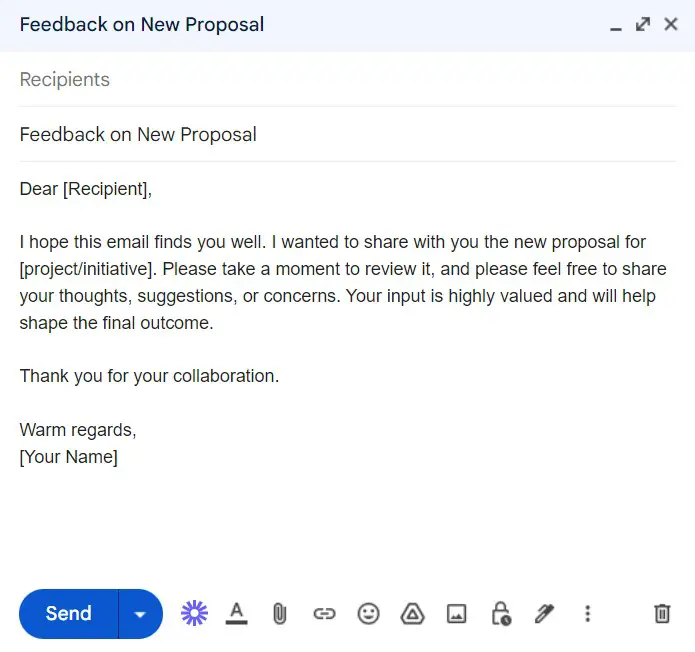Greetings, esteemed professionals!
In the realm of email communication, it’s crucial to foster an open and collaborative environment. One way to encourage dialogue and invite others to engage is by using the phrase “Please feel free to.”
This expression empowers recipients to share their thoughts, ask questions, or seek assistance without hesitation.
In this article, we will explore how to effectively use “Please feel free to” in emails, providing you with the tools to encourage open communication and create a welcoming atmosphere.
Let’s embark on the journey of mastering this phrase in email communication.
Contents
- How to Use “Please Feel Free to” in an Email
- “Please Feel Free to” Email Examples
- Example 1 – Subject: Feedback on New Proposal
- Example 2 – Subject: Questions About the Upcoming Event
- Example 3 – Subject: Seeking Input on Marketing Strategy
- Example 4 – Subject: Requesting Feedback on Website Redesign
- Example 5 – Subject: Exploring Partnership Opportunities
- Example 6 – Subject: Requesting Assistance with Project
- Example 7 – Subject: Invitation to Join Committee
- Example 8 – Subject: Request for Input on Training Program
- Example 9 – Subject: Requesting Feedback on Presentation
- Example 10 – Subject: Seeking Recommendations for Professional Development
- Alternative Ways to Say “Please Feel Free to” in an Email
How to Use “Please Feel Free to” in an Email
The phrase “Please feel free to” serves as an invitation for the recipient to share their input, seek clarification, or ask for assistance. Here are some key tips on using it effectively:
1. Encourage engagement: Use the phrase “Please feel free to” to create an environment where recipients feel empowered to share their thoughts, ideas, or concerns. It demonstrates your openness to their input and encourages collaboration.
2. Specify the topic or action: Clearly state the area or topic in which the recipient is invited to freely express themselves or take action. This helps direct their attention and prompts them to respond or engage in the specific context.
3. Offer assistance: Use “Please feel free to” as an invitation for the recipient to seek assistance or guidance. Let them know that you are available and willing to support them in their endeavors.
4. Maintain a welcoming tone: Keep your email warm and inviting to encourage open communication. Make it clear that their perspective is valued and that you appreciate their participation.
5. Be responsive: When you receive responses or inquiries from others, ensure you are prompt and receptive. This reinforces the trust and openness established through your initial invitation.
“Please Feel Free to” Email Examples
Example 1 – Subject: Feedback on New Proposal
Dear [Recipient],
I hope this email finds you well. I wanted to share with you the new proposal for [project/initiative]. Please take a moment to review it, and please feel free to share your thoughts, suggestions, or concerns. Your input is highly valued and will help shape the final outcome.
Thank you for your collaboration.
Warm regards,
[Your Name]
Example 2 – Subject: Questions About the Upcoming Event
Dear [Recipient],
Thank you for the invitation to the upcoming event. I am excited to attend. However, I have a few questions regarding the logistics and schedule. Please feel free to provide any additional information or guidance. Your support is greatly appreciated.
Looking forward to the event.
Best regards,
[Your Name]
Example 3 – Subject: Seeking Input on Marketing Strategy
Dear [Recipient],
I hope you’re doing well. We are in the process of developing a new marketing strategy for [product/service]. As an expert in the field, your insights and expertise are invaluable. Please feel free to contribute your ideas, suggestions, or any best practices you believe would be effective. We value your expertise and look forward to your input.
Thank you for your collaboration.
Sincerely,
[Your Name]
Example 4 – Subject: Requesting Feedback on Website Redesign
Dear [Recipient],
I trust this email finds you in good health. We have recently completed the redesign of our company website. We would greatly appreciate your feedback on the new layout, user experience, and overall design. Please feel free to share any thoughts or suggestions to help us enhance the website and better serve our customers.
Thank you for your time and input.
Warm regards,
[Your Name]
Example 5 – Subject: Exploring Partnership Opportunities
Dear [Recipient],
Thank you for your interest in collaborating with our organization. We believe our companies share similar values and goals. Please feel free to suggest any specific areas of collaboration or partnership that you believe would be beneficial for both parties. Your input is highly valued, and we are excited to explore the possibilities together.
Thank you for considering this opportunity.
Best regards,
[Your Name]
Example 6 – Subject: Requesting Assistance with Project
Dear [Recipient],
I hope this email finds you well. I am currently working on a challenging project and could use some guidance. As someone with extensive experience in [relevant area], I greatly admire your expertise. If you have any insights, resources, or recommendations that could help me overcome certain obstacles, please feel free to share them. Your support would be immensely appreciated.
Thank you for your willingness to assist.
Sincerely,
[Your Name]
Example 7 – Subject: Invitation to Join Committee
Dear [Recipient],
I am writing to invite you to join our committee on [topic/cause]. We believe your knowledge and expertise would greatly contribute to our efforts. Please feel free to accept the invitation and join us in our mission. Your participation and input would be highly valued.
Thank you for considering this invitation.
Warm regards,
[Your Name]
Example 8 – Subject: Request for Input on Training Program
Dear [Recipient],
Thank you for your valuable contributions to our training program. We are continuously striving to enhance the learning experience for our employees. If you have any suggestions, ideas, or specific topics you believe should be included in the upcoming sessions, please feel free to share them. Your expertise and insights are instrumental in shaping our program.
Thank you for your ongoing support.
Sincerely,
[Your Name]
Example 9 – Subject: Requesting Feedback on Presentation
Dear [Recipient],
I hope this email finds you well. I will be delivering a presentation on [topic] next week and would appreciate your input. If you have any suggestions to enhance the content or improve the delivery, please feel free to provide your feedback. Your expertise and guidance will undoubtedly contribute to a successful presentation.
Thank you for your time and insights.
Best regards,
[Your Name]
Example 10 – Subject: Seeking Recommendations for Professional Development
Dear [Recipient],
I trust this email finds you in good spirits. I admire your commitment to continuous learning and professional growth. If you have any recommendations for books, courses, or workshops that have had a positive impact on your own development, please feel free to share them. Your guidance and insights would be invaluable as I strive to enhance my own skills and knowledge.
Thank you for your support.
Warm regards,
[Your Name]
Alternative Ways to Say “Please Feel Free to” in an Email
While “Please feel free to” is a commonly used phrase, it’s beneficial to have alternative expressions to add variety and maintain engagement in your email communication.
Consider incorporating these alternatives:
- “You’re welcome to”
- “Don’t hesitate to”
- “Feel at liberty to”
- “I encourage you to”
- “You have my permission to”
- “You’re invited to”
- “I’m open to”
- “I welcome your”
- “I’m interested in your”
- “Your input is valued”
Using the phrase “Please feel free to” in your emails is a powerful way to create an open and collaborative environment.
By following the tips provided and utilizing the email examples, you can encourage engagement, invite input, and foster meaningful interactions with your colleagues, clients, and business partners.
Additionally, having alternative expressions at your disposal allows you to vary your language and maintain interest in your email communication.
Thank you for reading, and we wish you success in utilizing “Please feel free to” to promote open dialogue and collaboration in your email correspondence!


